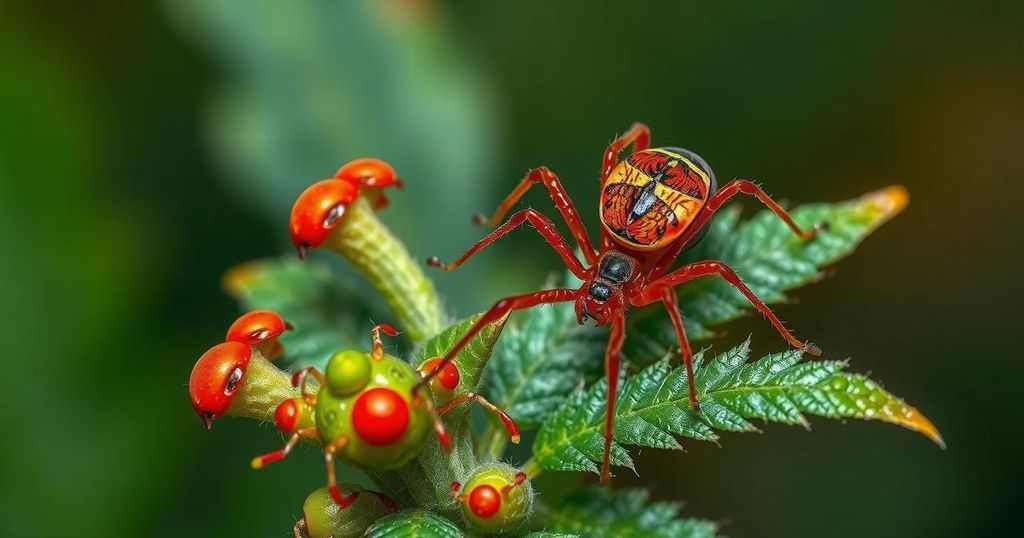Red spider mites have caused extensive crop losses in northwestern Libya, exacerbated by climate change. These pests thrive in dry conditions, leading to rapid infestations and challenging agricultural practices. Climate shifts have decreased rainfall and increased temperatures, facilitating the pests’ spread. Calls for improved pest management strategies and farmer support are urgent to combat their detrimental impact.
In northwestern Libya, the destruction wrought by red spider mites, tiny pests that flourish in arid conditions, has resulted in significant crop damage, affecting local agriculture and threatening wider regional food security. These mites, measuring less than half a millimeter, feed on sap from a diverse array of plants, leading to wilting leaves and falling fruits. This year has seen an unprecedented surge in infestations, with farmers at the Wadi Al-Hai agricultural development project reporting complete devastation of their fruit and vegetable crops. According to Fathi Al-Tahir, a plant protection expert with Libya’s Ministry of Agriculture, the severity of the infestations has escalated in recent years and is directly linked to climate change effects in the region. The Wadi Al-Hai project spans 12,000 hectares and is home to over 400 farms, where fruit trees, including figs and pomegranates, alongside various vegetables, are cultivated. Ashour Suwaisi, coordinator of agriculture and livestock in the Garyan municipality, indicated that the infestation has spread beyond the initial epicenter, infecting trees and crops in adjacent areas. Adaptable to various environmental conditions and capable of reproducing at alarming rates in higher temperatures, red spider mites have become a major agricultural threat in North Africa since their introduction in the mid-20th century through imported seedlings. Jamal Breim, a farmer impacted by the pest since 2017, highlighted the rapid and devastating spread that has resulted in substantial losses to his fig and pomegranate trees, expressing frustration over ineffective pesticide options and a lack of government support. Recent climatic changes, particularly decreased rainfall and heightened temperatures, have contributed to the proliferation of these pests, with Suwaisi noting a drastic reduction in annual rainfall in Wadi Al-Hai from 270 mm to just 50 mm. Al-Tahir observed that rising temperatures have shortened the life cycle of the mites, exacerbating crop losses as they thrive in the current climatic conditions, which are increasingly favorable to such pests. Concerns have arisen regarding the potential for pesticide resistance, as many North African nations predominantly employ acaricides to manage pests, leading to resistance issues. Rachid Boulmatat from ICARDA urged for the adoption of integrated pest management strategies, enhanced quarantine measures, and better training for farmers to combat this ongoing crisis effectively. Mohamed Amrani of the UN Food and Agriculture Organization emphasized the necessity for rigorous monitoring and laboratory capabilities to evaluate pesticide effectiveness. The impact of red spider mites has been extensive, reaching from Libya’s eastern regions to the western coast and affecting various agricultural zones. Abdul Majeed Al-Baghdadi, from Libya’s National Center for Prevention and Agricultural Quarantine, expressed intentions to initiate a combat campaign against the pest, contingent on securing adequate funding and stable security conditions.
The emergence of red spider mites as a significant agricultural pest in Libya is attributed to both their biological characteristics and the changing climate. Thriving in hot and dry conditions, these pests have adapted well to Libya’s environmental stresses, leading to rampant infestations. Historically, their presence in North Africa dates back to the mid-20th century with imports from Europe and Asia, but rising temperatures and decreasing rainfall have exacerbated their impact in recent years. The situation has become increasingly dire for farmers reliant on the agricultural sector, which is crucial for local economies and food supply. Enhanced international cooperation and more sophisticated agricultural practices are needed to mitigate these challenges, particularly in the context of climate resilience.
In conclusion, the surge of red spider mite infestations in Libya, fueled by climate change and subsequent environmental shifts, poses a serious threat to agricultural productivity and food security in the region. The rapid reproduction of the pests in warmer temperatures and their ability to spread across various crop types necessitate urgent and coordinated measures among farmers, government agencies, and international organizations. Enhanced pest management strategies, coupled with critical support mechanisms for affected farmers, are essential to address this burgeoning agricultural crisis.
Original Source: www.eurasiareview.com






